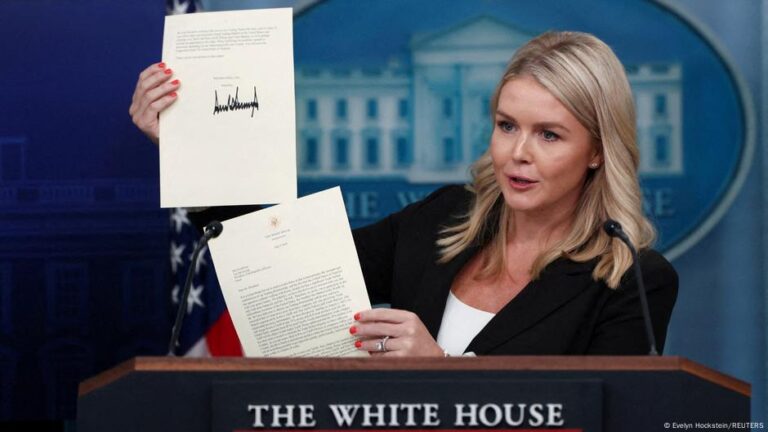US President Donald Trump announced new tariffs on 14 countries on Monday night, the majority of them in Asia.
He said the tariffs would kick in on August 1 but left the door open for further negotiations, saying the suggested tariffs were “more or less” final offers. “If [countries] call with a different offer, and if I like it, we’ll do it,” he said.
Which countries has Trump targeted and why?
Among the countries that Trump hit were Japan, South Korea, Cambodia, Indonesia, Thailand, Malaysia, Laos and Myanmar. Analysts say the focus on Asian countries is part of a move by the Trump administration to indirectly target China as part of its ongoing trade and strategic rivalry with the country.
China is by far the largest trading partner of Japan, South Korea, Malaysia, Myanmar and Indonesia and is the biggest source of imports for Cambodia and Thailand.
The move by Trump is likely aimed at putting pressure on these countries to strike agreements with the US as quickly as possible.
Some observers have suggested that plans to include countries’ trade relationships with China in the deals could backfire.
“Negotiations could prove problematic if, as some reports are indicating, the US is trying to get other parts of Asia to exclude China from regional supply chains,” Gareth Leather, senior Asia economist with Capital Economics, wrote in a note.
Since Trump’s so-called Liberation Day tariffs announcement on April 2, the White House has only reached tariff agreements with three countries: the UK, Vietnam and China.
The deal with Vietnam points towards US demands to target China. The US agreed to lower tariffs on Vietnam to 20% but includes a provision for a 40% tariff on so-called trans-shipping of goods, whereby China sells goods to third countries via intermediaries, such as Vietnam.
What exactly is trans-shipping?
Trans-shipping is the shipment of goods to an intermediate destination and then to another final destination. It is often a normal part of global trade but can also be a method used to disguise a product’s place of origin.
Earlier this week, the Financial Times published a report that suggested Chinese businesses were sending increased volumes of goods to the US via Southeast Asian countries, a form of trans-shipping aimed at avoiding new US tariffs on Chinese goods.
It cited data from the US Census Bureau that showed that while Chinese exports to the US had dropped by 43% year on year, its overall exports had risen by 4.8% in the same period, suggesting that it was rerouting goods to other parts of the world.
At the height of the tariff confusion in April, Trump’s team specifically cited Vietnam as an example of how trans-shipping was a problem.
Trump’s trade advisor, Peter Navarro, said Vietnam was “essentially a colony of communist China” in an interview with Fox News. “Vietnam sells us $15 for every $1 that we sell them, and about $5 of that is just Chinese product that comes into Vietnam, they slap a ‘Made in Vietnam’ label on it, and they send it here to evade the tariffs,” he said.
Vietnam template?
The fact that Vietnam has now done a deal provides an example of how other Asian countries might find a way to negotiate with Trump ahead of the August 1 tariffs kicking in.
However, Gareth Leather is doubtful, pointing to the fact that those countries may be concerned about damaging relations with China.
“This could open other countries up to retaliation from China, which is not only a bigger trading partner than the US but also a more important source of investment,” he wrote.
According to Capital Economics’ chief Asia economist Mark Williams, Vietnam had “one of the weakest hands” to play in negotiations with the US, given the amount of goods it sold to the country. Williams thinks the US trade deal with Vietnam isn’t a “template that other countries will feel they have to follow.”
“Instead, the key lesson for other countries from this deal, and that agreed previously by the UK, is that they will be expected to curtail some trade with China,” he wrote in a note to clients.
The deal the US struck with the UK in June includes provisions that Britain complies with strict American security requirements, such as scrutinizing supply chains and company ownership, a move seen as aimed at China.
Is it only about China?
In letters to the leaders of the countries hit with the August 1 tariffs, which Trump published on social media, the US president described their trade surpluses with the US as a “major threat to our economy and indeed our National Security.”
Given that the Trump administration has already reached a trade truce with China, the ongoing tensions with other Asian countries are not only about Beijing.
In recent weeks, Trump has focused on Japan, describing it as “spoiled” and criticizing it for not buying more US products, particularly agricultural goods. The focus on agricultural products also includes other Asian partners such as South Korea and India.
While Gareth Leather suggests most countries would be willing to make concessions to avoid a return to penal tariff rates, “for example, by stamping down on re-routing of Chinese goods,” other experts are more skeptical.
Bill Reinsch, senior economics adviser with the Washington-based Center for Strategic and International Studies (CSIS), doubts that certain Asian countries will go far enough to appease Trump, given his core unpredictability.
He told DW that what is likely holding them up is the sense that, “well, if we agree to something, are you going to come back two weeks later with sectoral tariffs on something else?”
He stated that if the US can’t be trusted not to move the goalposts, “it’s very hard to see people being willing to make commitments.”
Edited by: Uwe Hessler


